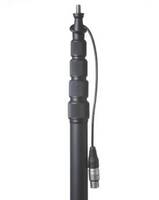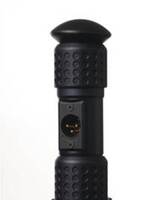 I hate to tell you this, but a good boompole will cost $250 to $400. A lot of machining and detail work goes into building a strong, yet lightweight and quiet, boompole.
I hate to tell you this, but a good boompole will cost $250 to $400. A lot of machining and detail work goes into building a strong, yet lightweight and quiet, boompole.
Carbon fibre (graphite) versus aluminum. There are a lot of myths about the "advantages" of carbon poles, but metal has some distinct benefits. The biggest myth is about overall weight. In the olde days, boompoles were constructed (it seemed) from pipe metal and could get really heavy. These days, we use aluminum alloy that is lightweight and durable. The difference in weight is negligible. Add the weight of an internal (or external) mic cable, shockmount, and the mic itself -- and it is not even worth computing.
Metal poles are far less expensive and far less fragile. They are quieter since the outer pole sections do not conduct vibration and handling noise as enthusiastically as carbon does.
A good length for a boompole would be 9 to 12 feet extended. Since the poles telescope, it is simple enough to collapse the sections if you are only doing news or documentary and do not need that much reach. But if you are doing narrative/dramatic films, the added length is necessary to keep the boomperson out of the shot.
Even if the boomperson does not need all of that length, it is far easier to hold a boom closer to the center of gravity than from the farthest end. Leverage can make a three pound boompole (with mic) feel like 20 pounds!
Teach the boomperson to hold the boom completely overhead with both arms so that the boompole is horizontal. The supporting arm should be straight up and down and held close to the head. If the supporting arm is held at too much of a horizontal angle, it puts strain onto the shoulder. Think of a gymnastic iron cross. The rear arm is the "steering" arm and controls the boom.
Supporting the boompole on a diagonal (like carrying a flagpole) will often cause the pole to cut across the frameline. If the boomperson cannot physically hold the pole for the duration of the shot, then position a lighting stand (with a sandbag or pillow on top) just under the elbow of the boomperson's arm. He or she can rest their elbow on the stand and take the weight off of their shoulder, yet still be in control and ready to move the boom if they have to follow the actors.
My favorite brand of boompole is K-Tek. They offer a metal 9 foot version (KE-110CCR) and a 12 foot version (the KE-144CCR). Prices are $275 and $350.
 The CCR designation is very important, as it denotes an internal coiled mic cable with a side-mounted XLR connector (see right). At the top of the boompole is a short XLR cable for attaching to the microphone. At the base of the boompole is a (chassis mount) XLR male connection for attaching to a standard microphone extension cable. This allows you to use as long or as short an extension cable as needed to connect the boompole to the camera or recorder.
The CCR designation is very important, as it denotes an internal coiled mic cable with a side-mounted XLR connector (see right). At the top of the boompole is a short XLR cable for attaching to the microphone. At the base of the boompole is a (chassis mount) XLR male connection for attaching to a standard microphone extension cable. This allows you to use as long or as short an extension cable as needed to connect the boompole to the camera or recorder.
It is important to use a side-mount connection rather than the very common bottom mount connection found on many, less expensive boompoles. When mic cables are plugged into the BOTTOM of boompoles, they will get broken! Boom operators tend to use the protruding XLR connectors as "handles" when they are stretching for extra reach. At the end of the take, poles are rested on their ends, with mic cables still attached!
As for using external cables wrapped barber pole style around the outside of the boompole…count me out! It makes extending or collapsing a pole very laborious and inconvenient. Not done properly will result in a ton of cable (clunking) noise. A tight wind may be quiet, but will put a lot of kinks into a good mic cable.
